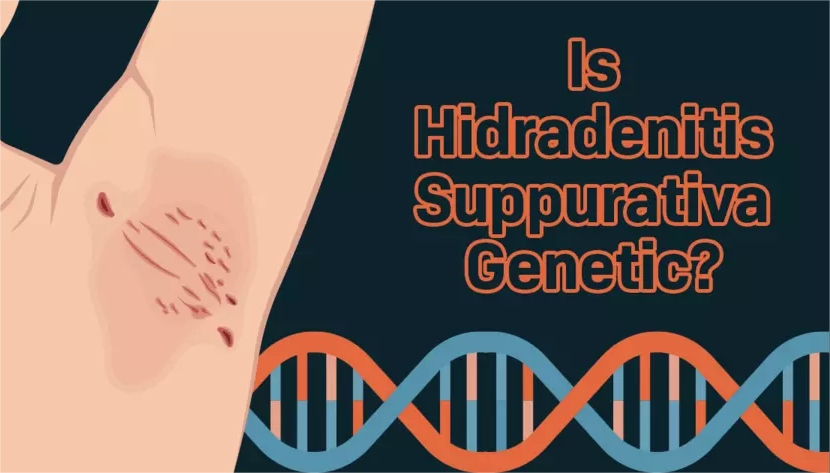Hidradenitis suppurativa (HS) is a chronic inflammatory skin condition characterized by painful nodules, abscesses, and sinus tracts, primarily affecting areas with apocrine glands, such as the axillae, groin, and buttocks. While the etiology of HS remains incompletely understood, mounting evidence suggests a significant genetic component in its pathogenesis. Understanding the genetic underpinnings of HS not only sheds light on its molecular mechanisms but also holds promise for improved diagnostics, prognostics, and targeted therapies.
Genetic Predisposition: Unveiling the Inheritance Patterns
One of the primary questions surrounding HS is whether it has a genetic basis. Family and twin studies have provided compelling evidence supporting a genetic predisposition to HS. First-degree relatives of individuals with HS have a significantly higher risk of developing the condition compared to the general population. Moreover, twin studies have demonstrated a higher concordance rate for HS among monozygotic twins compared to dizygotic twins, further underscoring the role of genetics in disease susceptibility.
Candidate Gene Studies: Exploring Potential Genetic Susceptibility Markers
Researchers have conducted numerous candidate gene studies in an attempt to identify specific genetic variants associated with HS. These studies have primarily focused on genes involved in immune regulation, inflammation, and skin barrier function. Variants in genes encoding components of the innate immune system, such as interleukin-1 (IL-1) and tumor necrosis factor-alpha (TNF-α), have been implicated in the pathogenesis of HS. Additionally, mutations in genes involved in keratinocyte differentiation and apoptosis, such as filaggrin (FLG) and caspase-1 (CASP1), have also been implicated in disease susceptibility.
Genome-Wide Association Studies (GWAS): A Holistic Approach to Genetic Discovery
While candidate gene studies have provided valuable insights into the genetic basis of HS, their scope is limited by the predetermined selection of genes for analysis. In contrast, genome-wide association studies (GWAS) offer a hypothesis-free approach to identify genetic variants associated with disease risk. GWAS analyze hundreds of thousands to millions of genetic markers across the entire genome to identify regions of the genome that are statistically associated with disease susceptibility. In recent years, GWAS have emerged as a powerful tool for uncovering novel genetic loci implicated in HS.
Several GWAS have been conducted in cohorts of individuals with HS, leading to the identification of multiple susceptibility loci. These loci encompass genes involved in various biological processes, including immune regulation, inflammation, and skin barrier function. Notably, many of these genes are also implicated in other inflammatory disorders, highlighting shared pathogenic mechanisms across different diseases. However, the functional significance of these genetic variants and their precise role in HS pathogenesis remain areas of active investigation.
Heritability and Polygenic Risk Scores: Quantifying Genetic Risk
Heritability estimates provide valuable insights into the proportion of phenotypic variation attributable to genetic factors. Studies have estimated the heritability of HS to be around 40-50%, indicating a substantial genetic contribution to disease risk. However, HS does not follow a simple Mendelian inheritance pattern, suggesting that multiple genetic factors, each exerting modest effects, contribute to disease susceptibility.
Polygenic risk scores (PRS) offer a means of quantifying an individual’s genetic predisposition to HS based on the cumulative effects of multiple genetic variants identified through GWAS. By aggregating information from thousands of genetic markers, PRS can stratify individuals into different risk categories, allowing for personalized risk assessment. Furthermore, PRS hold promise for identifying high-risk individuals for targeted screening and intervention strategies.
Challenges and Future Directions: Navigating the Genetic Landscape of HS
Despite significant progress in elucidating the genetic basis of HS, several challenges remain. The heterogeneity of HS phenotypes, ranging from mild to severe forms of the disease, poses a challenge for genetic studies aiming to identify robust genotype-phenotype associations. Additionally, the lack of large, well-characterized cohorts of individuals with HS hampers the statistical power of genetic analyses.
Moving forward, collaborative efforts involving large-scale international consortia are essential for overcoming these challenges and further unraveling the genetic complexity of HS. Longitudinal studies that incorporate clinical, genetic, and environmental data are needed to elucidate gene-environment interactions and refine risk prediction models. Furthermore, functional studies leveraging advanced molecular and cellular techniques are crucial for deciphering the biological mechanisms underlying identified genetic associations.
Conclusion
In conclusion, the genetic basis of HS represents a multifaceted puzzle with numerous pieces yet to be uncovered. While significant strides have been made in identifying genetic variants associated with HS susceptibility, much work lies ahead to fully elucidate the complex interplay between genetic, environmental, and immunological factors in disease pathogenesis. Nevertheless, insights gained from genetic studies hold the potential to transform our understanding of HS and pave the way for personalized approaches to diagnosis, treatment, and prevention.
























